Key takeaways
- Twill fabric features a distinct diagonal weave that provides durability, texture, and wrinkle resistance, making it ideal for t-shirts.
- It maintains its shape well after multiple washes, offering a structured and premium look for both casual and semi-formal wear.
- Twill fabric allows for sharp printing and defined embroidery, enhancing the quality of printed designs.
- Care for twill includes gentle washing, using mild detergents, and air drying to preserve its strength and texture.
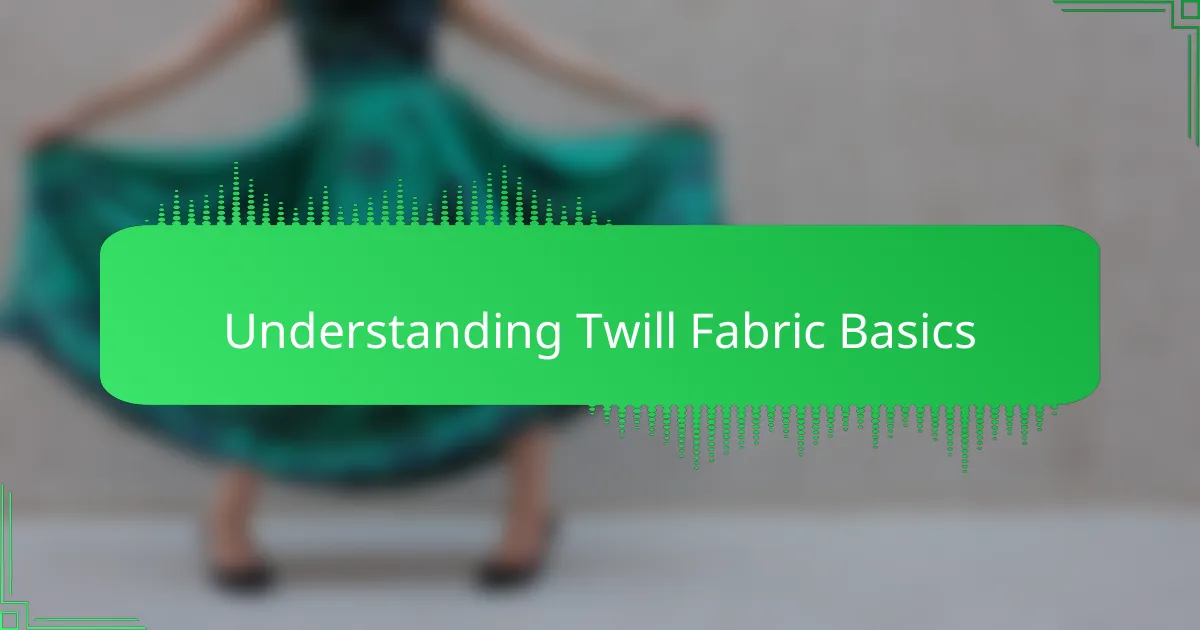
Understanding Twill Fabric Basics
Twill fabric stands out to me because of its distinct diagonal weave pattern, which gives it a unique texture and impressive durability. I’ve always found that this weave not only looks classy but also holds up well to wear and tear, which is essential for t-shirts that need to last. From my experience, twill has a nice balance of softness and strength, making it a reliable choice for designs that demand both comfort and structure.
| Characteristic | Twill Fabric |
|---|---|
| Weave Pattern | Diagonal lines, giving texture and durability |
| Durability | High; resists wrinkles and tears better than plain weaves |
| Texture | Soft yet sturdy; slight sheen |
| Comfort | Comfortable but slightly heavier than cotton jersey |
| Best Use | Structured t-shirts, casual and workwear styles |
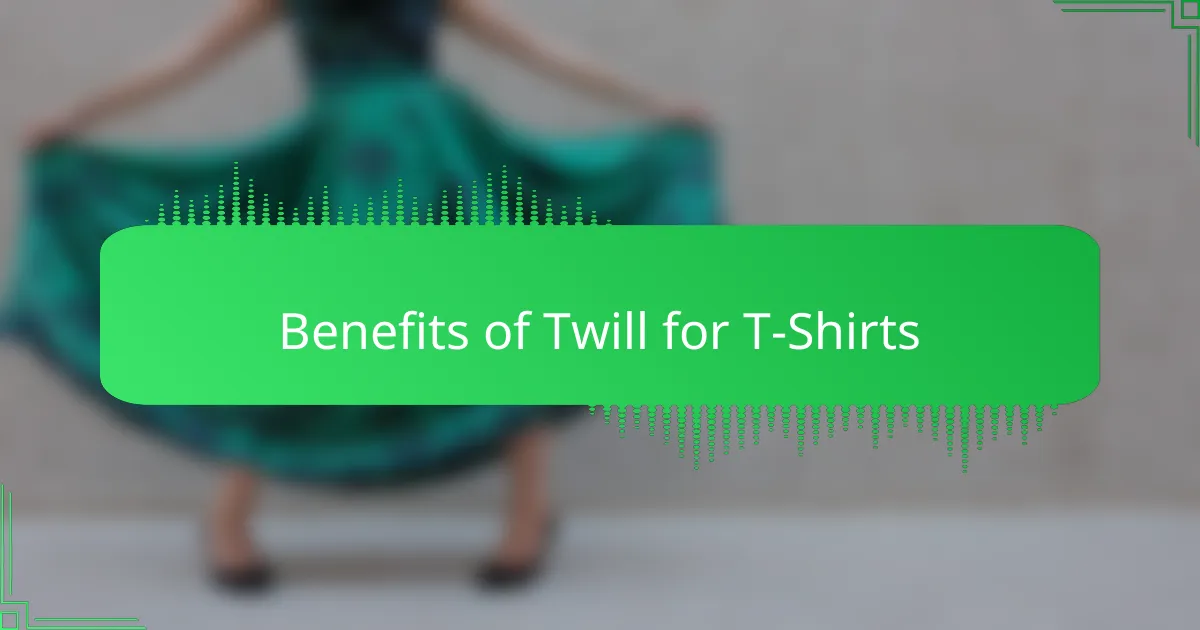
Benefits of Twill for T-Shirts
Twill fabric has truly surprised me with its durability and texture when used for t-shirts. From my experience, the distinctive diagonal weave not only gives the shirt a unique look but also makes it feel sturdier, which is perfect for everyday wear without worrying about quick wear and tear.
What I appreciate most about twill is how it maintains its shape and resists wrinkles, making those rushed mornings a little easier. Twill t-shirts have become my go-to when I want something that looks sharp without demanding too much care.
- Durable and long-lasting due to diagonal weave
- Unique textured appearance that stands out
- Resists wrinkles, keeping a neat look throughout the day
- Holds shape well even after multiple washes
- Comfortable yet sturdy, ideal for casual and semi-formal wear
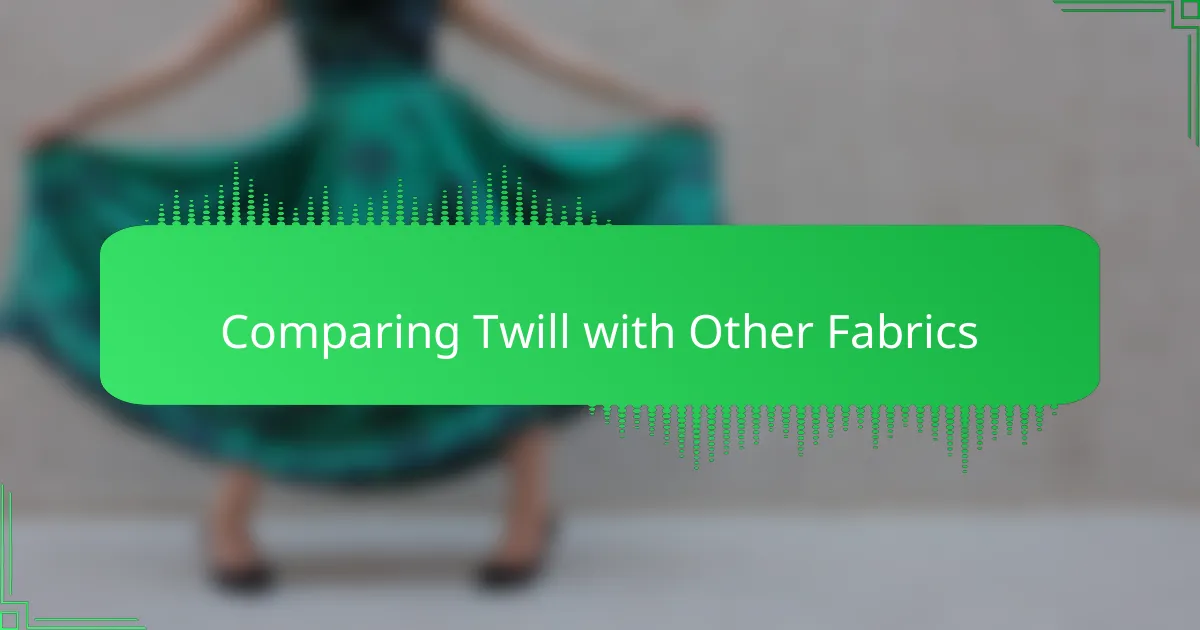
Comparing Twill with Other Fabrics
When I first compared twill to the more common cotton jersey fabric, I noticed how much thicker and more structured twill felt. While cotton jersey offers that light, breezy comfort perfect for lounge wear, twill adds a level of durability and texture that gives a shirt more character. Have you ever worn a t-shirt that feels like it actually could last through anything? That’s the kind of reliability twill brings to the table.
In contrast to plain weaves, twill’s diagonal pattern isn’t just for looks—it actually helps the fabric resist wrinkles and stains better. This means less fussing with ironing and washing, which is a huge plus for someone like me who’s always on the go and appreciates clothes that keep their shape without constant attention. It’s these practical benefits that make twill stand out compared to softer, but less sturdy, materials.
That said, twill isn’t the lightest fabric out there. Compared to knits or blends designed purely for softness, twill can feel a bit heavier on the skin. But for me, that slight weight adds to the confidence of wearing a well-crafted t-shirt that feels substantial and ready for anything. Do you prefer a softer feel or a tougher build in your t-shirts? For my day-to-day, twill strikes the perfect balance.
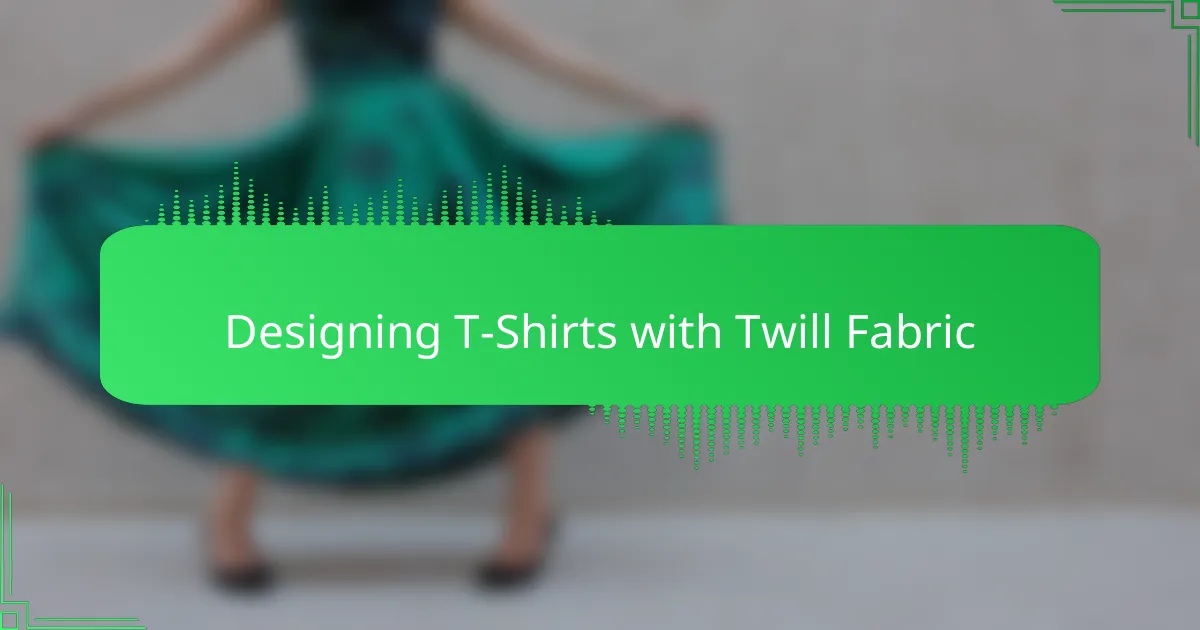
Designing T-Shirts with Twill Fabric
Designing t-shirts with twill fabric has been an eye-opener for me. The way the diagonal weave adds an almost sculptural quality to the shirt’s surface means it’s not just about comfort but also about making a subtle style statement. Have you noticed how twill t-shirts tend to hold their shape so well? That stability really changes how a design comes to life—it’s like the fabric itself supports the art.
One detail I’ve grown to appreciate is how twill’s texture interacts with different printing techniques. From what I’ve tried, screen printing looks sharper because the fabric’s sturdiness prevents ink from bleeding, while embroidery gains extra definition against the thick weave. It feels satisfying knowing the design will stay crisp, wash after wash, without fading into a blurry mess.
I do wonder, though, if twill’s slightly heavier feel might put off those who prefer ultra-lightweight tees. Yet, from my experience, that weight contributes to an elevated sense of quality and durability—not to mention the interesting visual depth it adds. When you want a t-shirt that’s a bit more substantial but still comfortable, twill is definitely a fabric worth exploring.
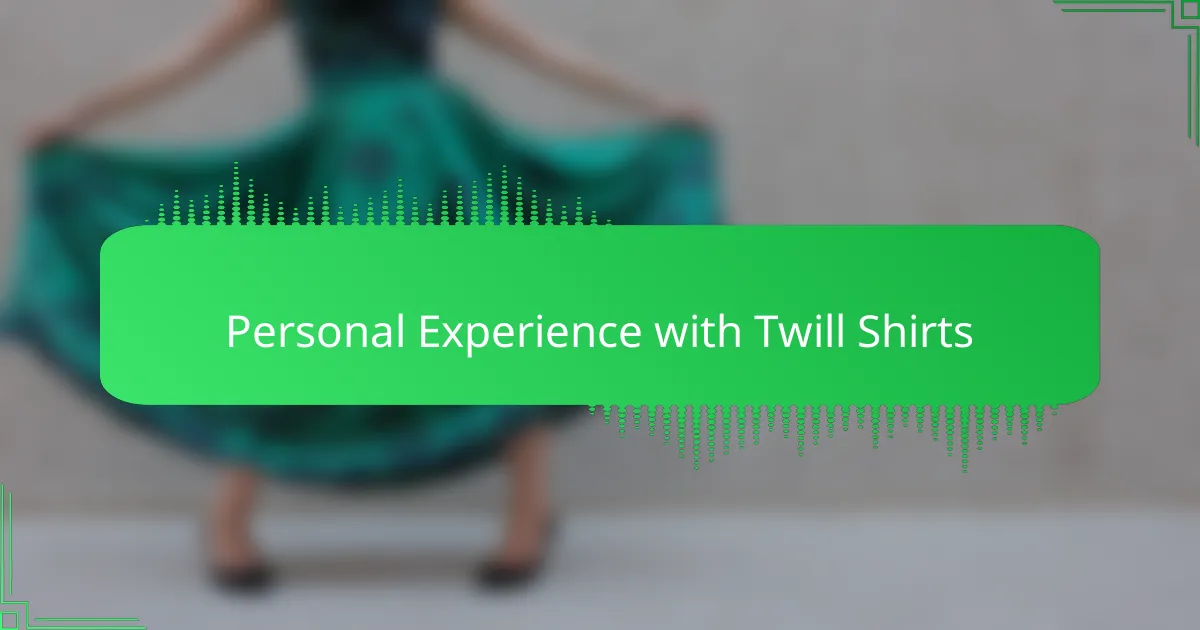
Personal Experience with Twill Shirts
Wearing twill shirts has been a game-changer for me, especially when it comes to durability and texture. I remember grabbing a twill shirt for a casual day out, and instantly, the fabric’s subtle diagonal weave gave it a sophisticated yet sturdy feel that I hadn’t experienced with typical cotton tees. It was comfortable, but more importantly, it held up beautifully after multiple washes without losing shape or softness.
One thing I really appreciate about twill is how it resists wrinkles, which means fewer moments of quick ironing before heading out. From my experience, this fabric feels more substantial, offering a sense of quality that I find reassuring when designing or choosing shirts for everyday wear.
Here’s what stood out to me about twill shirts:
– Durable and long-lasting fabric that withstands wear and washing
– Unique diagonal weave offering an interesting texture and visual appeal
– Excellent wrinkle resistance, saving time on maintenance
– Comfortable yet structured feel, good for both casual and semi-formal looks
– Retains shape and softness far better than standard cotton after repeated use
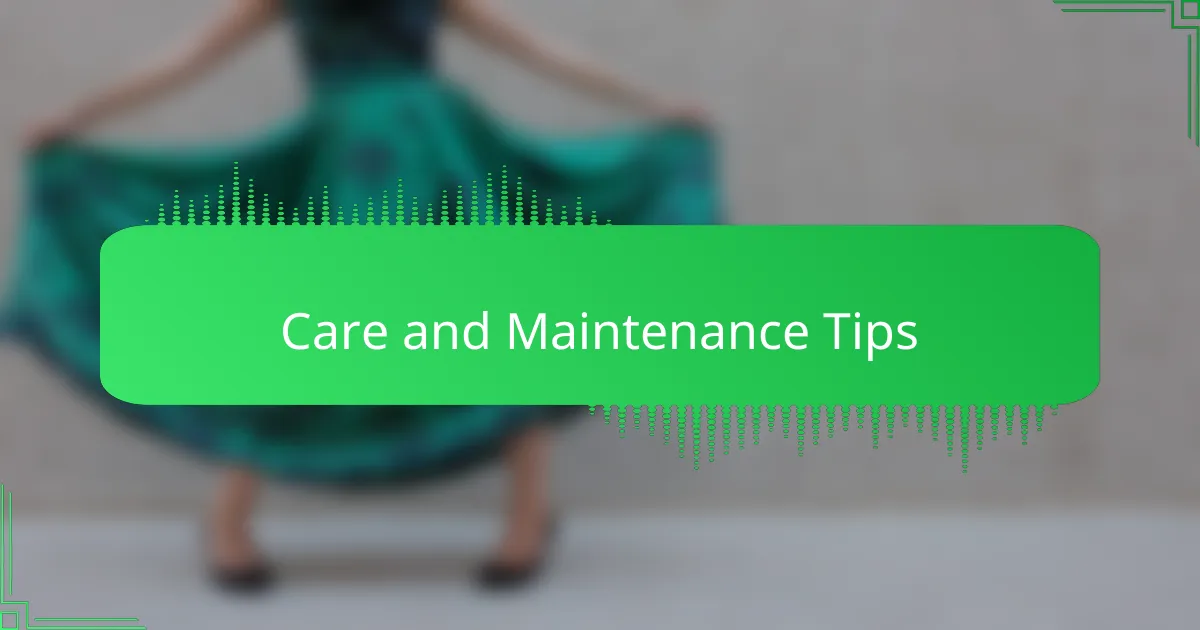
Care and Maintenance Tips
Taking care of twill fabric is simpler than you might think, but it does need a bit of attention to keep that texture and durability intact. From what I’ve seen, washing twill shirts inside out on a gentle cycle helps preserve the weave and prevents unnecessary fading. Also, skipping harsh detergents and using mild ones has made a noticeable difference in maintaining the fabric’s softness without sacrificing its sturdiness.
Have you ever noticed how some shirts shrink or lose their shape after the first wash? That didn’t happen with my twill tees when I air dried them flat instead of tossing them in the dryer. The weight and structure of twill mean it’s worth giving it a little extra time to dry naturally – it really helps the shirt keep its form and prevents any unwanted wrinkles or stretching.
Ironing twill isn’t a hassle either, especially since wrinkle resistance is one of its perks. I usually set my iron to a medium heat and press gently, feeling the fabric respond without worrying about scorching. Plus, a quick steam here and there often does the trick to freshen up the shirt, saving me time and effort while keeping it looking sharp. Have you tried steaming your shirts? It’s a game changer, especially for fabrics like twill that reward gentle care.

Final Thoughts on Twill in Design
Final Thoughts on Twill in Design
From my experience, twill fabric brings a unique texture and durability to t-shirt design that’s hard to match with other materials. I’ve found that its diagonal weave not only adds visual interest but also feels substantial and sturdy, which makes the finished product stand out. While twill may not be the softest option, its strength and wrinkle resistance often outweigh that for designs wanting a structured look.
| Aspect | Twill Fabric |
|---|---|
| Texture | Distinctive diagonal weave with a slightly raised surface |
| Durability | Highly durable and resistant to wear and tear |
| Wrinkle Resistance | Good resistance, holds shape well after washing |
| Comfort | Less soft compared to jersey, can feel firm initially |
| Design Impact | Creates a structured and premium look for garments |
